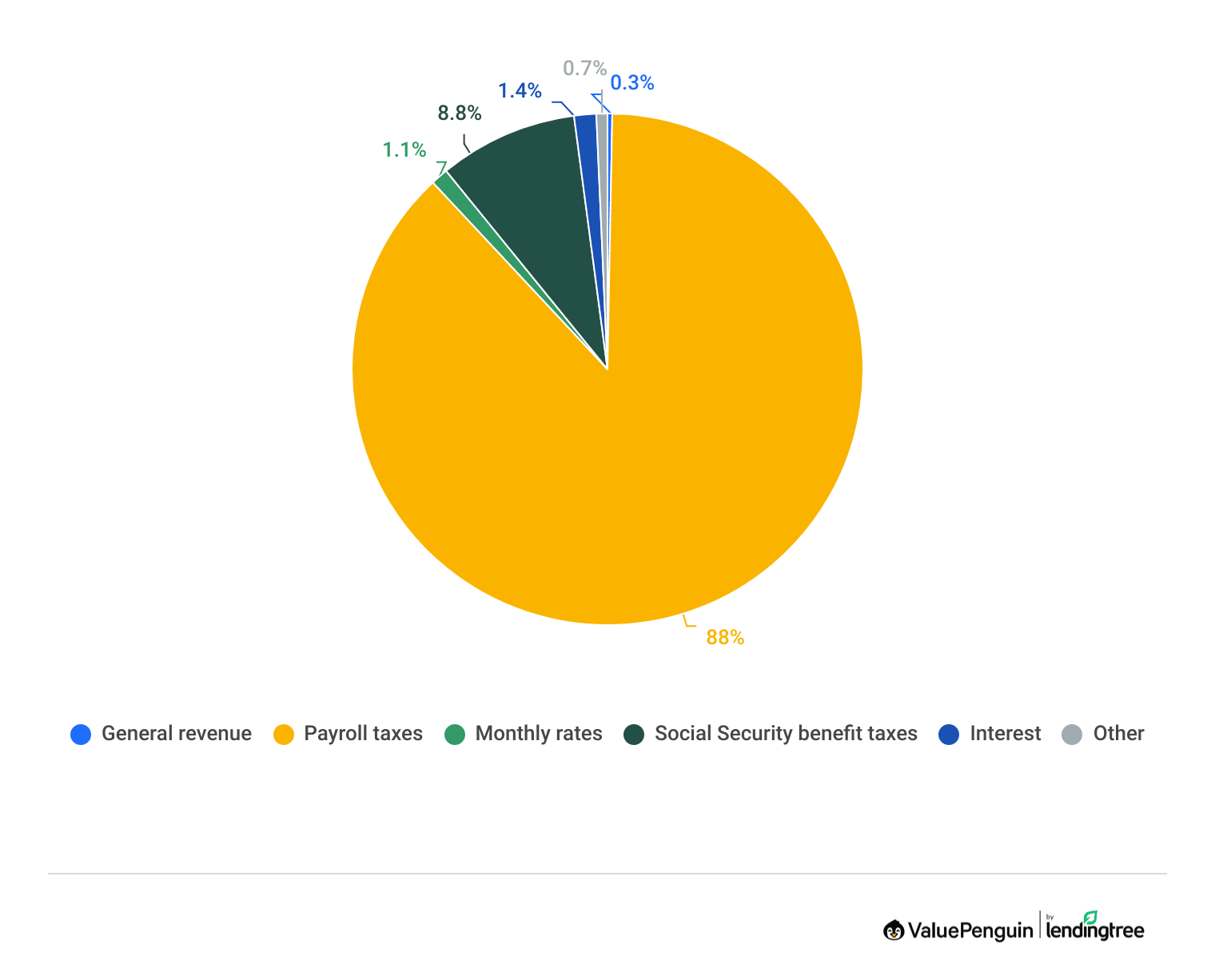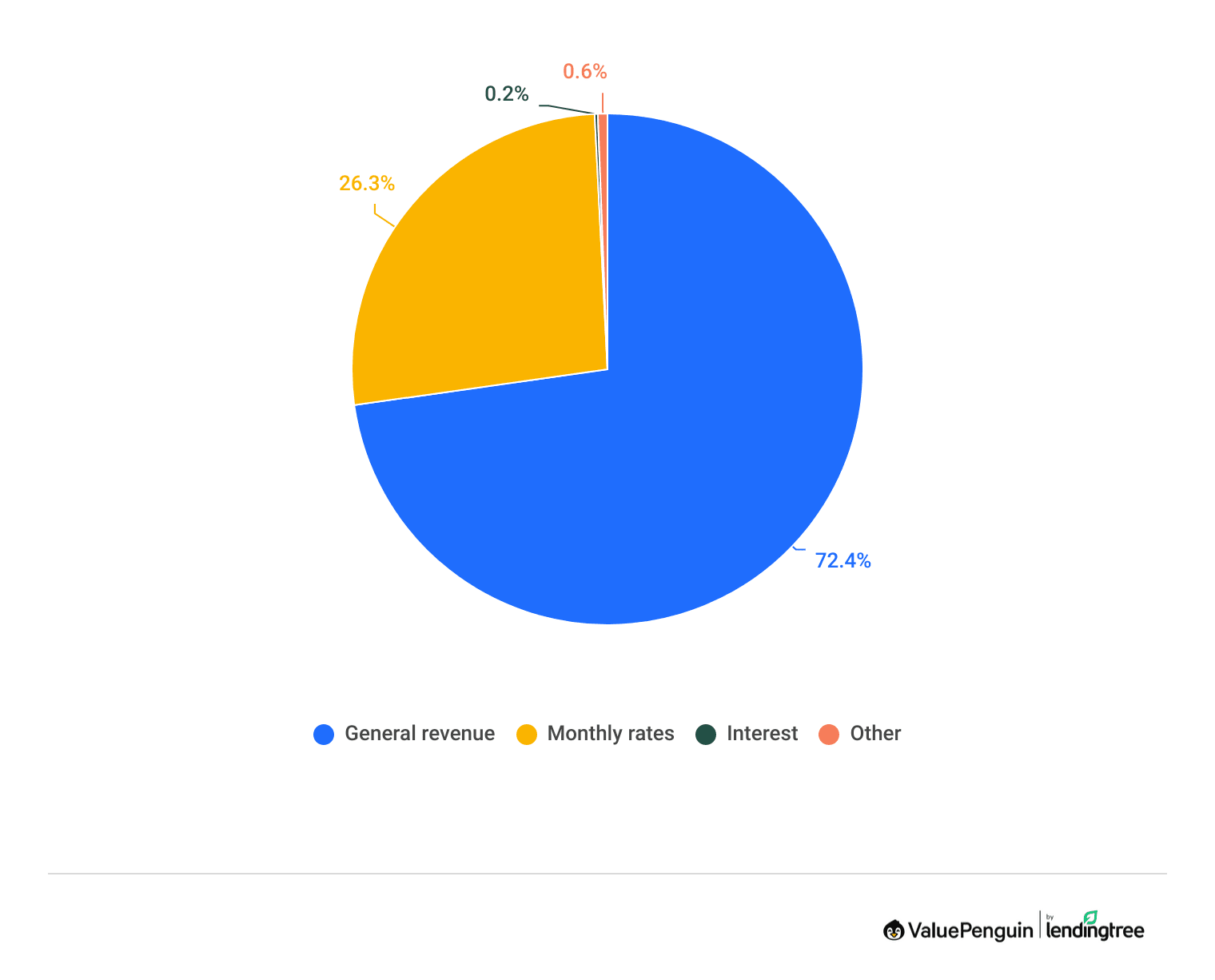How Is Each Part of Medicare Funded?
Medicare gets most of its funding through a combination of taxes and costs you're responsible for paying.
Compare Medicare Plans in Your Area
Other sources of funding include taxes on Social Security benefits, payments from states, and interest on payments and investments.
It's important to remember that Medicare is made up of several parts, and funding differs depending on which part of Medicare you're looking at.
Overview of Medicare funding
Medicare Part A (hospital care) gets most of its funding from payroll taxes, while Medicare Part B (doctor visits) is mostly funded by the federal government through a mix of various taxes and nontax sources, called general revenue. Most of the funding for Medicare Part D (prescription drugs) also comes from general revenue.
Medicare Advantage or Medicare Part C is funded by Parts A, B and D. In some cases, you may also pay a separate monthly rate depending on your plan details.
How is Medicare funded?
A Medicare Advantage plan lets you get bundled coverage through a private company. These plans offer the same coverage you'd get through Medicare Parts A and B. Plus, most plans offer extra benefits such as prescription drug coverage, vision, dental and fitness memberships.
Medicare cost breakdown
Category | Overall (Parts A, B and D) | Part A | Part B | Part D |
|---|---|---|---|---|
| General revenue | 44.0% | 0.3% | 72.4% | 74.8% |
| Payroll taxes | 35.0% | 88.0% | N/A | N/A |
| Monthly fees paid by enrollees (premiums) | 14.5% | 1.1% | 26.3% | 12.9% |
| Taxation of Social Security benefits | 3.5% | 8.8% | N/A | N/A |
| Transfers from states (for dual eligible Medicare-Medicaid) | 1.6% | N/A | N/A | 12.1% |
| Interest | 1.0% | 1.4% | 0.2% | 0.2% |
| Other | 0.4% | 0.7% | 0.6% | 0.1% |
| Total income (billions) | $1,133.3 | $451.2 | $532.9 | $149.3 |
Figures may add up to more than 100% due to rounding.
Compare Medicare Plans in Your Area
How is Medicare Part A funded?
You pay for Medicare Part A through income taxes.
Medicare Part A is primarily funded by a 2.9% payroll tax that's split between the employer and employee. If you earn a high income, you may pay a slightly higher percentage.
Contractors and other self-employed individuals have to pay the full 2.9% Medicare tax.
In 2025, 88% of Medicare Part A funding came from payroll taxes. Taxes on Social Security benefits are responsible for another 9%, and the remaining 3% came from the federal government's general revenue and monthly rates paid by some Medicare Part A enrollees.
Most Medicare enrollees don't pay anything for Part A while they're enrolled in Medicare. For those over age 65, that's because of the Medicare taxes paid on income while working. Similarly, those who qualify for Medicare through a disability or medical condition also do not have to pay for Medicare Part A while enrolled.
How is Medicare Part B funded?
About three-quarters of the budget for Medicare Part B comes from various taxes and other forms of government funding, called general revenues.
Almost all of the remaining funding comes from the monthly rate all Medicare Part B enrollees have to pay. Interest on Social Security payments accounts for less than 1% of all Part B funding.
Your Medicare Part B rate changes each year depending on inflation. In 2026, most people pay $202.90 per month for Part B, although some high earners have to pay more because of an extra surcharge, called IRMAA.
How is Medicare Advantage (Part C) funded?
Medicare pays private insurance companies a fixed cost per month for each enrollee.
In total, Medicare spends more than $494 billion on Medicare Part C funding each year.
The program also offers extra payments to cover Medicare Advantage plans with drug coverage. These funds covered more than 33.6 million people enrolled in Medicare Advantage or 54% of everyone on Medicare.
A complex bidding process determines exactly how much the government pays per plan member. Factors such as the health of the plan member and insurance costs help determine how much money companies get.
Many Medicare Advantage plans have no extra monthly costs for enrollees. Regardless of whether you have Original Medicare or Medicare Advantage, you'll still have to pay your $202.90 Medicare Part B monthly rate.
How is Medicare Part D funded?
Roughly three-quarters of Medicare Part D funding comes from general revenue.
Monthly rates paid by Part D enrollees account for another 13%, and another 12% comes from state governments.
Medicare Part D pays for prescription drug coverage. You can get a stand-alone Part D plan through a private company if you have Original Medicare (Parts A and B). Most Medicare Advantage plans offer Part D benefits as part of your bundled coverage.
Medicare Part D is optional. But it's usually a good idea to buy Medicare Part D when you first become eligible, to avoid high drug costs later on.
How are Medicare Supplement plans funded?
You pay for the entire cost of your Medicare Supplement (Medigap) plan.
Unlike other parts of Medicare, supplemental plans don't get any money from the government. Instead, they're entirely supported by the costs you pay for coverage each month.
Medigap plans cover the roughly 20% of medical costs you're responsible for paying with Original Medicare (Parts A and B). Plans are sold and managed by private companies, although coverage is strictly regulated by the government.
In other words, if you get a Medigap Plan G from Aetna, it would have the exact same coverage as a Plan G policy from Blue Cross Blue Shield. The only difference is the cost you pay and the service you get.
Medicare trust funds
The government uses two trust funds to pay for Medicare Parts A, B and D.
- The Hospital Insurance (HI) Trust Fund is used to finance Medicare Part A.
- The Supplemental Insurance (SMI) Trust Fund covers Parts B and D.
These funds get money from a variety of sources including monthly rates paid by enrollees, money that's directly authorized by Congress and interest earned from investments.
Sources of funding by trust fund
- Payroll taxes
- Part A monthly rates
- Interest from investments
- Taxes on Social Security benefits
- Funds authorized by Congress
- Part B monthly rates
- Interest from investments
Frequently asked questions
How is Medicare funded?
Most Medicare funding comes from taxes including the Medicare payroll tax and various others that feed into what's called the general federal revenue. Monthly rates paid for by Medicare enrollees, interest earned from investments and taxes on Social Security benefits are other sources of funding for Medicare.
Is Medicare federally funded?
Yes, most of the money Medicare gets comes from the federal government. Only a very small amount of funding comes from state governments, in the form of small contributions for enrollees who qualify for both Medicare and Medicaid.
Who funds Medicare Part C?
Medicare Advantage plans (Part C) get most of their funding from the Centers for Medicare and Medicaid Services (CMS). Some plans also charge enrollees a monthly rate.
Sources
Information about Medicare funding came from the Centers for Medicare and Medicaid Services (CMS) 2025 Annual Report.
Senior Writer
Talon Abernathy is a ValuePenguin Senior Writer who specializes in health insurance, Medicare and Medicaid. He's also contributed to other insurance verticals including home, renters, auto, motorcycle and flood insurance.
Talon came to ValuePenguin in 2023. Since his arrival, he's helped to expand the site's health insurance-related content offerings. He enjoys helping readers understand the ins and outs of America's all too complicated health insurance landscape.
Before coming to ValuePenguin, Talon worked as a freelance writer. His prior work has touched on a broad range of personal finance-related topics including credit-building strategies, small business incorporation tactics and creative ways to save for retirement.
Insurance tip
In many parts of the country, you can qualify for a free Silver health insurance plan if you meet certain income requirements. Government subsidies in the form of premium tax credits and cost-sharing reductions may mean you'll pay nothing for coverage.
Expertise
- Health insurance
- Medicare and Medicaid
- Flood insurance
- Homeowners insurance
- Renters insurance
- Auto and motorcycle insurance
Referenced by
- The Miami Herald
- Money.com
- MSN
- Nasdaq
- The Sacramento Bee
- Yahoo! Finance
Education
- BA, University of Washington
- Certificate in Copyediting, UC San Diego
Credentials
- Licensed Life & Disability Insurance Agent
- Licensed Property & Casualty Insurance Agent
Editorial Note: We are committed to providing accurate content that helps you make informed financial decisions. Our partners have not endorsed or commissioned this content.




